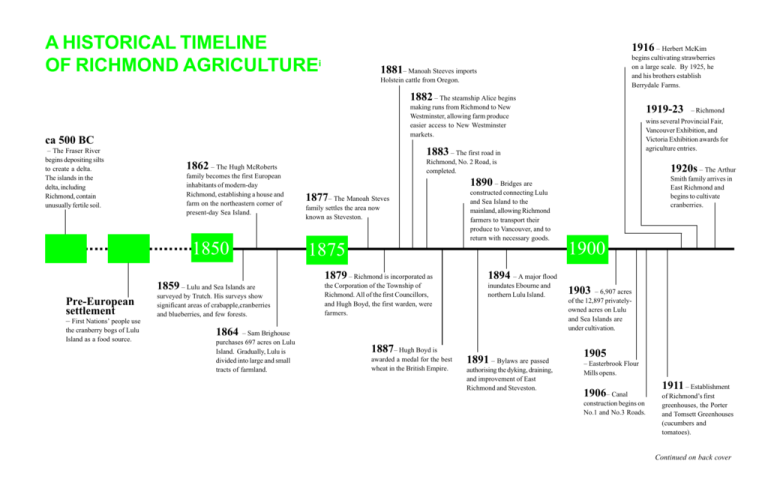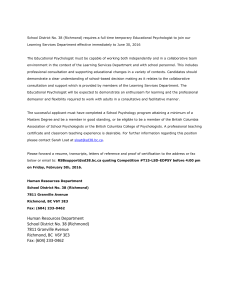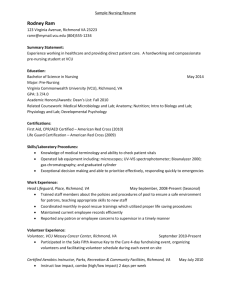A Historical Timeline of Richmond Agriculture
advertisement

A HISTORICAL TIMELINE OF RICHMOND AGRICULTUREi 1916 Herbert McKim begins cultivating strawberries on a large scale. By 1925, he and his brothers establish Berrydale Farms. 1881 Manoah Steeves imports Holstein cattle from Oregon. 1882 The steamship Alice begins ca 500 BC The Fraser River begins depositing silts to create a delta. The islands in the delta, including Richmond, contain unusually fertile soil. family becomes the first European inhabitants of modern-day Richmond, establishing a house and farm on the northeastern corner of present-day Sea Island. 1859 Lulu and Sea Islands are First Nations people use the cranberry bogs of Lulu Island as a food source. Richmond, No. 2 Road, is completed. surveyed by Trutch. His surveys show significant areas of crabapple,cranberries and blueberries, and few forests. family settles the area now known as Steveston. 1875 1879 Richmond is incorporated as the Corporation of the Township of Richmond. All of the first Councillors, and Hugh Boyd, the first warden, were farmers. constructed connecting Lulu and Sea Island to the mainland, allowing Richmond farmers to transport their produce to Vancouver, and to return with necessary goods. Smith family arrives in East Richmond and begins to cultivate cranberries. 1887 Hugh Boyd is awarded a medal for the best wheat in the British Empire. 1900 1894 A major flood inundates Ebourne and northern Lulu Island. 1864 Sam Brighouse purchases 697 acres on Lulu Island. Gradually, Lulu is divided into large and small tracts of farmland. 1920s The Arthur 1890 Bridges are 1877 The Manoah Steves Richmond wins several Provincial Fair, Vancouver Exhibition, and Victoria Exhibition awards for agriculture entries. 1883 The first road in 1862 The Hugh McRoberts 1850 Pre-European settlement 1919-23 making runs from Richmond to New Westminster, allowing farm produce easier access to New Westminster markets. 1891 Bylaws are passed authorising the dyking, draining, and improvement of East Richmond and Steveston. 1903 6,907 acres of the 12,897 privatelyowned acres on Lulu and Sea Islands are under cultivation. 1905 Easterbrook Flour Mills opens. 1906 Canal construction begins on No.1 and No.3 Roads. 1911 Establishment of Richmonds first greenhouses, the Porter and Tomsett Greenhouses (cucumbers and tomatoes). Continued on back cover 1922 Frasea Farms, Richmonds largest dairy, is established. From this time until WWII, many dairies are established in Richmond. 1928 Richmonds population hits 6,841. 1930s The Richmond Berry Growers Association is founded, representing 55 Japanese farmers. 1990s None of 1954 Frasea Farms is sold/expropri- Richmonds ALR land is removed. ated to make way for the expansion of Vancouver International Airport. 1930s The Depression hits and farm produce prices fall through the floor. 1999 Richmonds Official 1957-Late 1960s The Oak Street, 1930s Electric drainage pumps Community Plan commits the City to protecting the supply of agricultural lands and to ensuring the viability of farm operations and sets in motion proactive strategies to increase the productive use of these lands. Knight Street, and Arthur Laing Bridges, and the Deas Island (now the George Massey) Tunnel, are built. These transportation linkages further encourage Richmonds development. are established at Finns Slough, the south end of No. 3 Road, and the north end of No. 4 Road. 1933 The Columbia Potato Growers Association is founded. 1925 1939-1945 WWII. As part of the war effort, the airport is expanded. The Federal Government expropriates it and its environs, including much farmland. 1943 The BC Coast Vegetable Co-operative Association, a major marketing cooperative, is formed. 1944 Leslie Gilmore, of Richmond, produces the most potatoes per acre of anyone in Canada. Post-1945 The baby boom begins, and Richmonds development rapidly increases, placing more pressure on farmland. 2000 1975 1950 1962 The immense Brighouse Estate, largely agricultural, is purchased by the City of Richmond. It now includes much of the current City Centre area of the municipality. 1970s Richmonds population grows to nearly 90,000 people, and commercial, industrial, and residential expansion increases. At the same time, agricultural production per acre also grows. 1979 Richmond turns 100. 2002 Richmond 1980s Several areas of Richmonds ALR are removed for industrial and residential development, including Terra Nova. Agricultural Viabilty Strategy endorsed by Council. 1989 The Richmond Farmers Institute is incorporated. The first president is Bruce May. 1974 The Agricultural Land Reserve is created, permanently zoning most of Richmonds farmland for agricultural use. i Sources: North et. al, 1979; Ross, 1979; and Ross, 1989.





